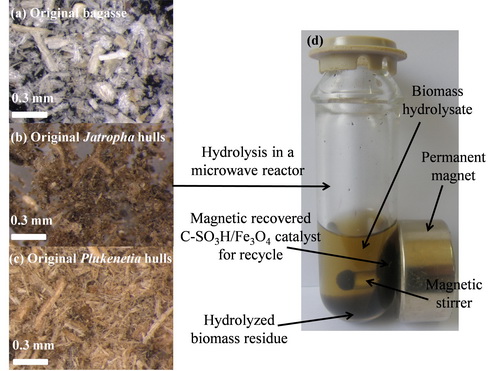Many biomass residues are produced in China and it is important to volatilize them, such as conversion of them to sugars by hydrolysis. The hydrolysis of lignocelluloses in concentrated and diluted homogenous acids has been practiced for many years. However, problems such as corrosion hazards, acid-waste and difficulties in separation are not solved effectively. Many techniques are developed for biomass pretreatment to reduce the recalcitrance and crystallinity of cellulose, and increase its surface area for improving hydrolysis efficiency and selectivity.
Prof. FANG Zhen and his team of Xishuangbanna Tropical Botanical Garden (XTBG) are trying to make the technique of biomass treatment easier and stable. They reported a work that synthesized magnetic sulfonated acid from glucose and magnetized it without chemical reactions by simply mixing magnetic Fe3O4 nanoparticles with aqueous glucose solution.
The researchers prepared magnetic catalyst (C-SO3H/Fe3O4) by evaporation the mixture of Fe3O4 nanoparticles and aqueous glucose solution, and pyrolysis in a tubular furnace at temperature of 700 oC for 1 h, and sulfonated by 98% H2SO4 in oil bath at 150 oC for 20 h. They synthesized and screened catalyst C-SO3H/Fe3O4 with strong magnetism (19.5 Am2 kg−1) and high total acid density (0.75 mmol g−1, NaOH titration) for the hydrolysis of cellulose and tropical plant wastes of sugarcane, Jatropha curcas and Plukenetia volubilis in microwave reactor.
They found that the best hydrolysis conditions for ball-milled cellulose were optimized with single-factor optimization with the yields of reducing sugars and glucose of 25.3% and 22.4%, respectively. The catalyst was used to hydrolyze bagasse, Jatropha and Plukenetia hulls with the highest glucose yield of 58.3%, 35.6% and 35.8%, respectively.
By using the magnetic carbonaceous acid with microwave, pretreatment of tropical biomass greatly improved hydrolysis yield glucose. The catalyst had a good stability and after seven cycles, it showed no obvious deactivation.
The study entitled “Hydrolysis of Selected Tropical Plant Wastes Catalyzed by a Magnetic Carbonaceous Acid with Microwave” has been published in Scientific Reports.
Contact
FANG Zhen Ph.D Principal Investigator
Key Laboratory of Tropical Plant Resources and Sustainable Use, Xishuangbanna Tropical Botanical Garden, 88 Xuefu Road, Kunming, Yunnan Province 650223, China
E-mail: zhenfang@xtbg.ac.cn
Tel: 86 871 65137468

The tropical plant wastes and catalyst separated by a magnet after reaction.(Image by SU Tongchao) |

